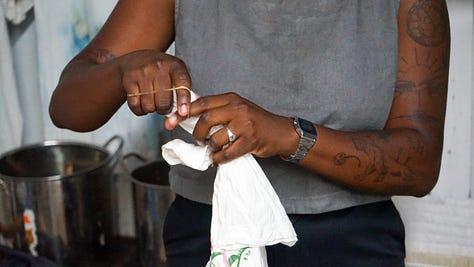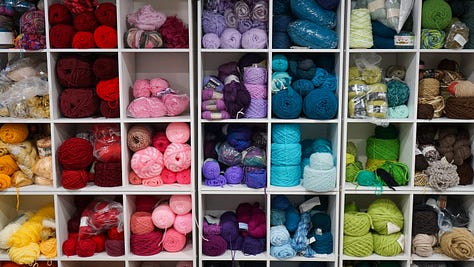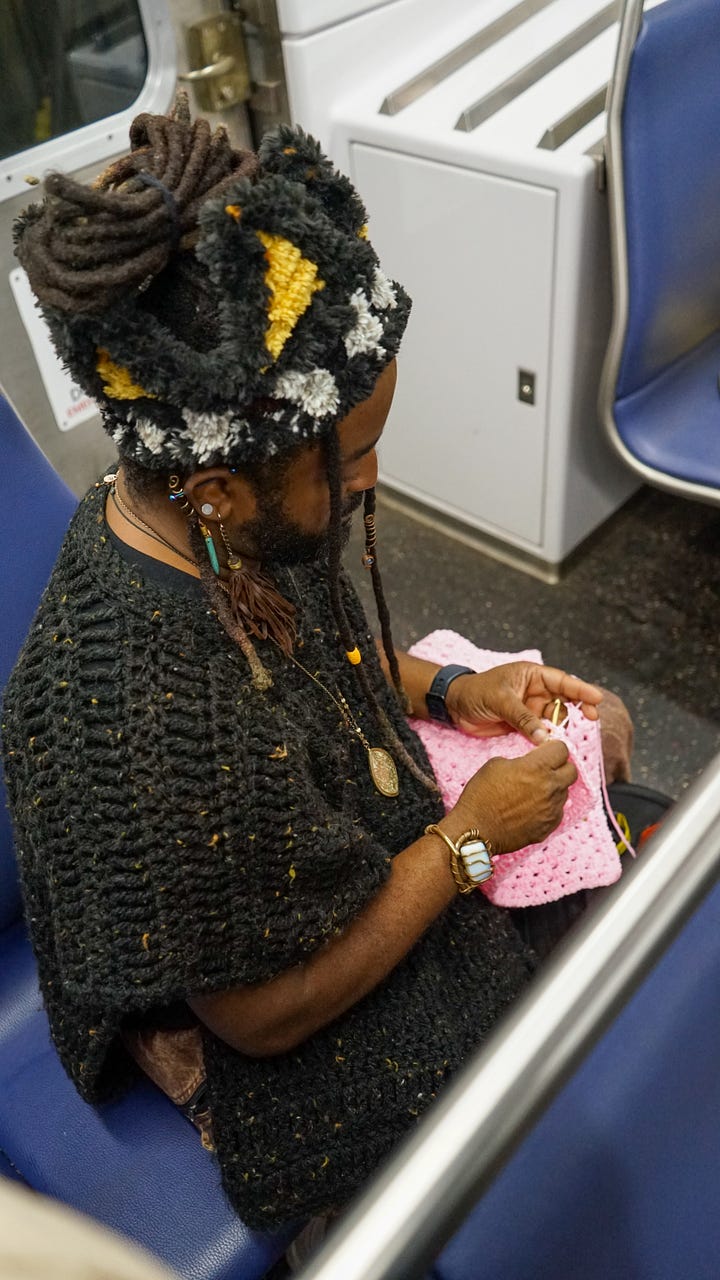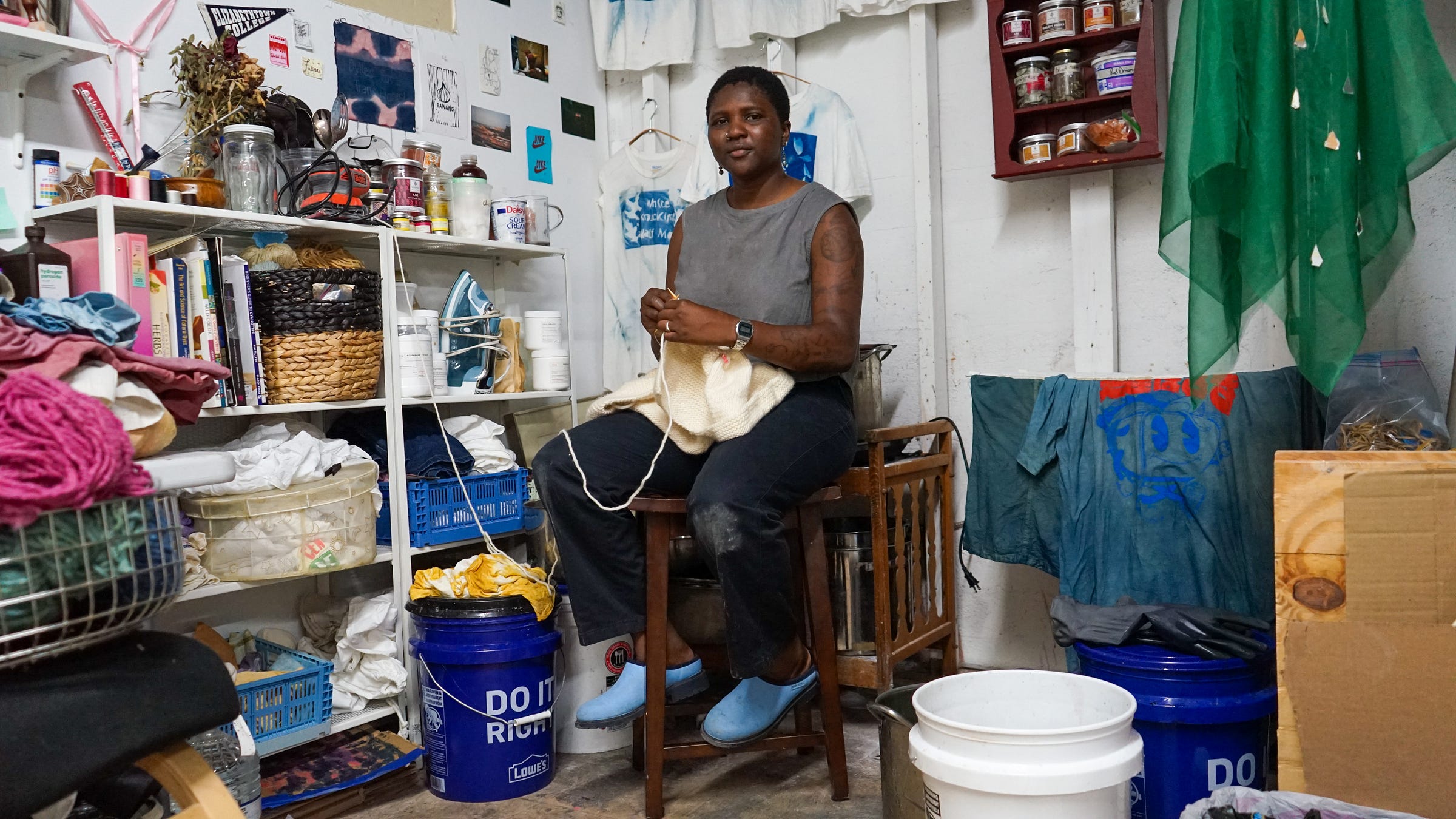Fiber is intimately, inextricably intertwined with life. From the clothes that drape and hug our bodies, the pillows that cradle, the bags we tote, to the rugs we walk all over - we are surrounded. What practicing fiber art offers is not only an appreciation for the skill it takes to make these comforts but also the community that is embedded in the craft. Three artists show us how.
Fatima Janneh began knitting in 2018 and would soon find herself engrossed by the complex and surprisingly ancestral process of natural dying. Stacy Cantrell started crocheting at four years old, now a master crocheter, she recently stepped down from a three-year tenure as President of the 80-year-old Potomac Fiber Arts Guild. Dwayne Lawson-Brown, a DC native known as the CrochetKingpin, has been crocheting for nearly 20 years and hosts a monthly crochet circle.
Janneh, who is Gambian-American, learned to knit from a college friend. She liked keeping her hands busy and making gifts for friends and loved ones. Later, while working at a local coffee shop, a regular introduced her to natural dyeing techniques. Janneh started with café scraps like spent coffee grounds and cherry pulp. She initially considered it an experiment, but the more she dyed, the more she felt drawn into the process.
“And a month into doing that, I told my mom, and she was like, ‘Your great-grandmother did that.’” On the phone, Janneh responded, “‘What are you talking about? Why didn't you tell me before?’”
Janneh’s great-grandmother, Neneh Njie, died long before she was born, and yet this practice stretched through time to her coffee shop job and found her. This familial connection deepened her art practice which combines poetry, dyed fabric, knitting, and embroidery.
In one work by Janneh, a large white rectangle of silk has yellow stars, eco-printed with onion skins, evenly spaced around the sides, at the center is a blue column made through a cyanotype process. Text in the blue column reads: “I was in love, a new year was beginning, and the shape of the future was a widening star.” The quote is from Audre Lorde’s, Zami: A New Spelling of My Name.
“I feel like my whole life I have felt so disconnected and have tried so hard to keep in contact with family and learn more about Gambia. And this just really tied in so much I didn't know I was looking for.” Janneh continued, “Especially finding that out really invigorated my drive to want to know. I feel as though in my practice, I never want to stop learning.”



From a college friend who shared their love of knitting, to a coffee shop regular who introduced Janneh to natural dye, her art practice has been shaped by community and now it continues to build community. She regularly teaches workshops on natural dye processes. She also began remaking some of those special projects she made when she first started knitting, this time using her acquired skills as a natural dyer – recreating vibrant rainbow blankets using wool and the dyes she mixes herself in her studio.
“I feel like I've been very lucky in finding people who are receptive to sharing their knowledge, and also sharing what they don't know. And I'm like, yeah, same. I don't know a lot, and that's okay, and that's really exciting.”
Like Janneh, central to Stacy Cantrell’s art practice is sharing the value and skill in craft. Cantrell calls herself a master crocheter, and looking around her home studio, that title comes with good reason.
Cantrell’s art spans from traditional to abstract to sculptural. One of her sculptures is the life-size crocheted Aphrodite of DC, Cantrell’s take on Venus de Milo. In her studio are coral reefs, a life-size cactus tree with an owl, and a mermaid all crocheted in three dimensions. In the middle of the studio is a structural form that will soon support a sculpture of Medusa pulling a bow and arrow. Her latest work in progress is a series of sculptures and wall hangings exploring the complex representations of Medusa through time.
Cantrell is also the outgoing President of the 80-year-old Potomac Fiber Arts Guild. The guild started from a small group of weavers who would meet at a Smithsonian, where one of the members worked. Over time the Guild expanded welcoming all fiber techniques like weaving, knitting, spinning, and of course, crocheting. The guild still regularly hosts meetings, workshops, artist talks, and study groups.
During quarantine, the guild had to adapt, offering virtual meetings and classes. This led to an increase in attendance as craft participation was surging. Today they continue to share resources online, along with meeting recordings. This past April, the guild moved into a shared workspace to reengage in-person participation. We met there to talk. Cantrell sat at a table near the entrance of Artists and Makers while a crochet study group met in the workspace behind her.
The Guild maintained steady membership numbers through quarantine, but they recently reached a new milestone, just passing 350 members, said Cantrell. With the early Pandemic came a surge in interest in fiber craft, and with guilds and artists across the country providing more resources online, honing craft skills became achievable from home. Now, as the world continues to recover, and shifts to hybrid or in-person, craft communities continue to adapt – and they must.
Over the years, Cantrell noticed shifts in membership, including more men participating. She also noticed older guild members were beginning to retire from their craft. As an older generation begins to set down their looms, crochet hooks, knitting needles, and walk away from their spinning wheels, the younger generation will need to carry craft forward. She emphasized the need for intergenerational learning, bringing in younger members, and increasing diversity in membership across racial and gender spectrums.
Cantrell sees online resources as a powerful tool with limitations. What the Guild offers is detailed, personal instruction. There are some techniques, said Cantrell, that cannot be taught from online resources alone, especially specialized processes like wet felting custom boots or projects that take multiple days. These not only require hands-on instruction but they also require the space and material to engage in large, and in this case wet, multi-step processes.



She assured, “I don’t care if you learn [fiber craft] from your next-door neighbor, your family member, YouTube, Instagram – I don’t care where you learn it. If you learn it, and you get interested, and you create – that’s all that really matters.”
Cantrell continued, “So you may not have been handed down the skills from your family, like what has been tradition for hundreds and thousands of years. Technology has been able to fill in that gap, and hopefully, it'll re-perpetuate it forward.”
Dwayne Lawson-Brown, aka the Crochet Kingpin, was born and raised in DC. They are a fiber artist, educator, and community organizer. They often wear their own crocheted clothing creating a unique style that invites. Maybe it’s the material of crochet, a comforting, hand-cared-for medium, unreplaceable via machine. Maybe it’s Lawson-Brown’s ease and their willingness to see and be seen. Instantly, upon meeting them IRL, it felt like seeing a friend again and it had been way too long.
Lawson-Brown hosts Spinning a Yarn: Crochet Circle, a monthly workshop for beginning and experienced crocheters at Phillips@THEARC. In an article about the workshop from The Phillips Collection, Lawson-Brown explains, “I create a piece inspired by the artwork we will be exploring. In what we have dubbed ‘ekphrastic crochet,’ after a brief lesson on the artist and artwork that has inspired this month’s materials, I present my creation and discuss the connections.”
Their inspired artworks include sweaters, hats, and scarves that reference their chosen artwork from the collection. In the article, Lawson-Brown says, “I chose pieces that have interesting lines and shapes, dynamic color choices, and challenges that push me as a creative, while remaining simple enough that a beginner can learn within those restraints.”


Lawson-Brown found crochet around 2004 through a girlfriend, an avid latch hook crafter. They thought if they were going to make this relationship work, they better pick up a craft. The next time they went out to get more supplies, Lawson-Brown found a book with crochet instructions, resulting in nearly 20 years of practicing fiber art.
Over that time, they have noticed men are not often seen or represented as fiber crafters, but when crocheting in public, like on the metro, Lawson-Brown is approached.
“Men come to me and whisper, ‘Hey, I know that’ or ‘I learned that when I was locked up.’” They continued, “Although I'm non-binary, I often present masculine. Men feel safe sharing their bit of craft with me.”
Through teaching, Lawson-Brown saw people who didn’t find success with instructional books or online resources pick up the art of crochet in an hour at an in-person workshop.
“I've seen elders who haven't left their house since 2020 join a circle and find community again. I've had tough conversations about masculinity, patriarchy, and the pressure to constantly produce while practicing granny squares.”
In one work, Lawson-Brown fused performance art, activism, and crochet during DC Emancipation Day in 2022. They crocheted themselves into a red, white, and blue “cocoon representing the binding nature of taxation without representation.”
They continued, “Fiber art is a skill, but it's also a tool for starting tough conversations and creating change. For some, it's family dinner, for us – the crafting table.”
Support these artists:
Fatima: Instagram | Website | Cashapp: $FatimaJanneh | Venmo: Fatima-23
Stacy: Instagram | Website | Potomac Fiber Arts Guild | Become a member
Dwayne: Instagram | Website | Cashapp: $CrochetKingpin | Venmo: CrochetKingpin
Words and pictures by Shelby Hubbard | Follow warp_dmv on Instagram








